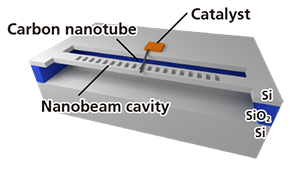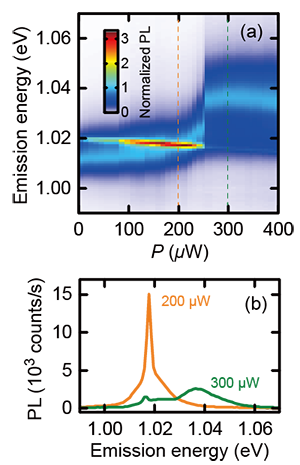Research:Spectral tuning of optical coupling between air-mode nanobeam cavities and individual carbon nanotubes
Carbon nanotubes are attractive for nanoscale telecom band emitters on the silicon platform. When they are integrated into air-mode nanobeam cavities, efficient coupling to photonic structures and large emission enhancements are expected, and they can be utilized to make ultrasmall light sources in integrated photonics.
Spectral detuning between the emitters and the cavities is an important factor affecting such effects, and post-fabrication tuning of optical coupling would be a key for further applications.

In this work, we utilize heating-induced molecular desorption to tune the nanotube emission in and out of the cavity resonance. Air-mode nanobeam cavities are fabricated from silicon-on-insulator wafers, and carbon nanotubes are suspended over the cavities by chemical vapor deposition.
We have measured excitation power dependence of the photluminescence spectra on those devices. As we heat up the device by increasing the laser power, a large blueshifting of the broad nanotube peak is observed, while the sharp cavity peak slightly redshifts. When the nanotube and the cavity peaks are overlapped, we observe the largest emission enhancement, which is 10 times brighter than the off-resonance emission.

To learn more about this work, please refer to:
Spectral tuning of optical coupling between air-mode nanobeam cavities and individual carbon nanotubes
Appl. Phys. Lett.
112, 021101 (2018).
![]()